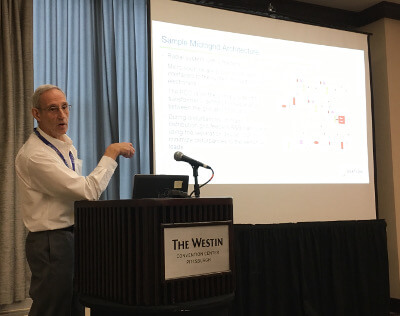 At the 2017 Ovation Users Group conference, Emerson’s Fred Huff presented on microgrid controls. Fred opened describing a microgrid as one that could stand alone or connect to the larger electrical grid. Components include distributed generation (DG), loads—critical and non-critical, energy storage systems (ESS), points of common coupling (PCC) and a microgrid controller.
At the 2017 Ovation Users Group conference, Emerson’s Fred Huff presented on microgrid controls. Fred opened describing a microgrid as one that could stand alone or connect to the larger electrical grid. Components include distributed generation (DG), loads—critical and non-critical, energy storage systems (ESS), points of common coupling (PCC) and a microgrid controller.
Fred focused on the control components of microgrids. Microgrids help reduce transmission losses, provide high quality and reliable energy supply to critical loads, can prevent main grid overloads, adds affordable power to remote areas, and encourages renewable energy sources.
Voltage and frequency can be difficult to control without a grid connection and electrical energy needs to be stored. It is also difficult to resynchronize when attached to the main grid. Microgrids can be remote and never connected to a main grid, such as an offshore oil & gas platform. They can also be self-contained but connected to the main grid, such as a large hospital.
Fred shared an example of an industrial plant with boilers and steam turbines which could run as an island or connected to the main grid to sell power back to the utility supplying the plant. For a set of oil & gas platforms. Using generators on some platforms and undersea cables to others, with backup emergency generators—this is an example of islands and sub islands microgrid architecture.
Microgrid control functions include PCC monitoring & control, frequency control, load shedding, voltage (reactive power) control, remote breaker control & monitoring, and synchronization. These components have been in plants for decades. What’s new is the inclusion of renewable sources into the mix.
Plants must monitor their usage from the grid due to demand limit contract terms. Consuming more than a demand limit may push them into a higher price level for the next year. To address this challenge many facilities will have automatic load shedding to remove non-critical load to stay under the limit.
Frequency control is critical when connected to the grid. Isochronous generators take on the frequency control with droop generators taking on enough load so that the Isochronous generator has room to take additional load to maintain frequency. Inverters converting battery DC voltage to AC voltage can be set up in master and slave arrangements like Isochronous and droop generator arrangements to maintain frequency regulation while handling changing loads.
Load shedding control needs to have sub 100msec response time. It is capable of monitoring hundreds of discrete loads and bringing on inverters and other sources rapidly. Good load shedding control strategies start with planning what if scenarios to assess different conditions, such as loss of main grid. For each contingency case, there is a list of loads to shed from the grid. Critical loads remain connected. It’s important to make which loads are shedded and not visible to the operators so they know what should and should not be powered. Load blocking is the case where large loads are blocked from re-engaging on the grid until there is enough supply to accept them without excessive voltage or frequency drop.
Controlling power factor is another critical factor. Utilities can charge large penalties for plants with too large of inductive loads. Capacitor banks with automatic connections are used to try to maintain the power factor near unity. Another area of control is on transformer tap changes. By adjusting the tap position on the transformer can help control voltage on the bus immediately downstream of the transformer.
The Ovation distributed control system acts as a secondary microgrid controller integrated and controlling all distributed energy sources and support multigrid arrangements.
